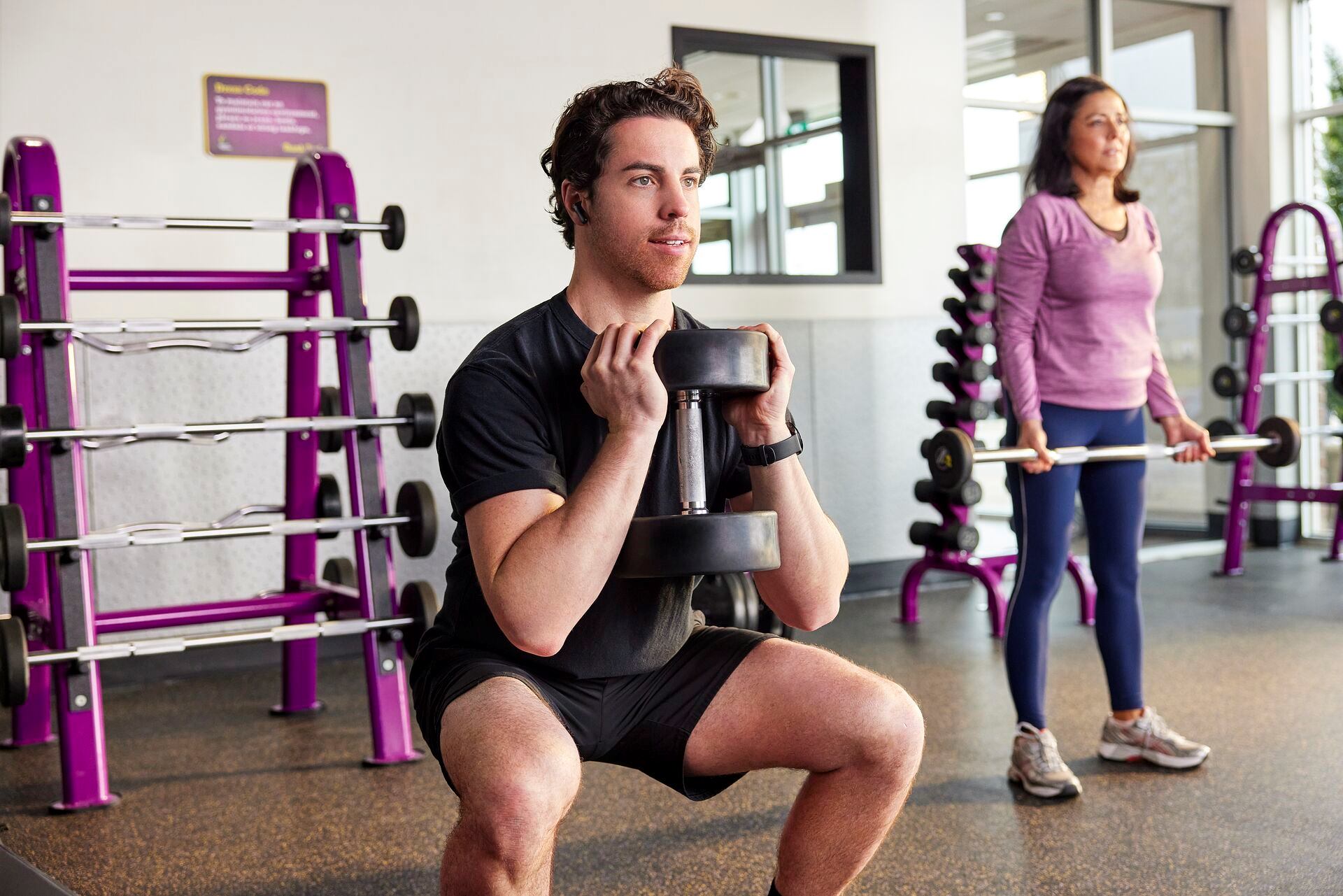

Featured
Why Do Muscles Burn During Exercise
Published: October 2, 2023
Experience the burning sensation in your muscles during exercise? Discover why muscles burn during workouts and how to alleviate discomfort. Featured article.
Introduction
When we engage in physical activity, whether it’s running, weightlifting, or even just taking a brisk walk, we often experience a burning sensation in our muscles. This burning sensation can range from mild discomfort to intense pain, causing us to wonder why our muscles burn during exercise.
To understand why muscles burn during exercise, it’s important to have a basic understanding of how our muscles work. Muscles are made up of fibers that contract and relax, allowing us to move our bodies. During exercise, our muscles undergo a series of chemical and mechanical processes that generate the energy needed to perform the activity.
The burning sensation in our muscles is commonly referred to as “muscle burn.” This sensation is often experienced during intense or prolonged physical activity and is a sign that our muscles are working hard. While muscle burn can be uncomfortable, it is generally considered a normal and expected response to exercise.
There are several factors that contribute to the sensation of muscle burn during exercise. These factors include the accumulation of lactic acid, muscle fatigue and microtears, inadequate oxygen supply, and excessive load or repetition. Understanding these factors can help us better manage and alleviate muscle burn during our workouts.
In this article, we will explore the causes of muscle burn during exercise and discuss strategies to alleviate this sensation. By understanding why our muscles burn and implementing effective strategies, we can optimize our workouts and achieve our fitness goals with greater comfort and success.
Understanding Muscle Burn
Muscle burn refers to the sensation of burning or discomfort that occurs in our muscles during exercise. This sensation is often accompanied by fatigue and a decrease in muscle strength. Understanding the underlying mechanisms behind muscle burn can help us better cope with it during our workouts.
During exercise, our muscles require energy to contract and perform the desired movement. This energy is generated through a process called cellular respiration, which involves the breakdown of glucose and the production of adenosine triphosphate (ATP). The demand for energy increases during exercise, leading to an increased metabolism and the release of heat as a byproduct.
One of the main contributors to muscle burn is the buildup of lactic acid. Lactic acid is a byproduct of anaerobic metabolism, which occurs when our muscles are working at a high intensity and cannot receive sufficient oxygen. As lactic acid accumulates in our muscles, it can cause a burning sensation and muscle fatigue.
Muscle burn is also associated with muscle fatigue and microtears. When we engage in intense or prolonged exercise, our muscles experience microtears in their fibers. These microtears are a normal part of the muscle adaptation process and are necessary for muscle growth and strength development. However, they can also contribute to the sensation of muscle burn.
Furthermore, inadequate oxygen supply can lead to muscle burn. Oxygen is essential for the efficient production of ATP through aerobic metabolism. When our muscles are working at a high intensity, the demand for oxygen exceeds the supply, leading to anaerobic metabolism and the accumulation of lactic acid.
Lastly, excessive load or repetition can also contribute to muscle burn. When we push our muscles beyond their current capacity or repeat the same movement excessively, our muscles can become overwhelmed and fatigued. This can result in a prolonged burning sensation and decreased performance.
Overall, muscle burn is a normal physiological response to exercise. It indicates that our muscles are working hard and adapting to the demands placed upon them. Understanding the causes of muscle burn can help us better manage and cope with this sensation, allowing us to push past our limits and achieve our fitness goals.
Causes of Muscle Burn During Exercise
There are several factors that contribute to the sensation of muscle burn during exercise. Understanding these causes can help us better manage and alleviate this discomfort, allowing for more effective and enjoyable workouts.
1. Lactic Acid Accumulation: When we engage in high-intensity exercise, our muscles require more energy than can be supplied through normal aerobic metabolism. In this anaerobic state, glucose is broken down without oxygen, resulting in the production of lactic acid. The build-up of lactic acid in our muscles contributes to the burning sensation and muscle fatigue associated with exercise.
2. Muscle Fatigue and Microtears: As we push our muscles to work harder or engage in repetitive movements, fatigue and microtears occur in the muscle fibers. These microtears are a natural part of the muscle repair and growth process. However, they also contribute to muscle burn and discomfort during and after exercise.
3. Inadequate Oxygen Supply: During intense exercise, the demand for oxygen by our working muscles may exceed the available supply. As a result, our muscles shift to anaerobic metabolism, leading to the production of lactic acid and an increased perception of muscle burn.
4. Excessive Load or Repetition: This can be due to overtraining or improper form during exercise. By placing excessive load on our muscles, they become overwhelmed and fatigued. Additionally, repeating the same movement excessively without proper rest can contribute to muscle burn.
It’s important to note that muscle burn is not always a negative sign, as it can indicate that our muscles are being challenged and stimulated for growth. However, excessive or prolonged muscle burn can lead to discomfort and hinder our ability to perform optimally.
By understanding the causes of muscle burn, we can take steps to alleviate it and optimize our workouts. In the following sections, we will explore strategies to help alleviate muscle burn and enhance our exercise experience.
Lactic Acid Accumulation
Lactic acid accumulation is a key factor in the sensation of muscle burn during exercise. It occurs when our muscles are working at a high intensity and cannot receive enough oxygen to meet their energy demands. Understanding the role of lactic acid in muscle burn can help us better manage and prevent discomfort during our workouts.
During aerobic metabolism, our muscles break down glucose to produce energy in the presence of oxygen. However, during intense exercise, our bodies may not be able to deliver enough oxygen to the working muscles. As a result, our muscles switch to anaerobic metabolism, where glucose is broken down without oxygen, leading to the production of lactic acid.
Lactic acid is a byproduct of this anaerobic breakdown of glucose. As lactic acid accumulates in our muscles, it lowers the pH level, creating an acidic environment. This increase in acidity contributes to the burning sensation and muscle fatigue commonly associated with muscle burn.
Contrary to popular belief, lactic acid itself does not cause muscle soreness. The burning sensation and subsequent muscle soreness are primarily due to the accumulation of hydrogen ions resulting from the conversion of lactic acid into lactate and hydrogen ions. These hydrogen ions interfere with muscle contraction and contribute to muscle fatigue.
However, it’s important to note that lactic acid accumulation serves a beneficial purpose. It acts as a energy source during short bursts of intense activity and plays a role in the conversion of glucose to glycogen, which is stored in our muscles and used as fuel during exercise. Additionally, lactic acid accumulation triggers a cascade of physiological responses that enhance our endurance and performance over time.
To manage and prevent excessive lactic acid accumulation, it’s important to employ strategies that optimize our exercise routine. These strategies include:
- Gradually increasing the intensity and duration of our workouts to allow our muscles to adapt and improve their ability to utilize oxygen efficiently.
- Incorporating interval training and high-intensity interval training (HIIT) into our routine, which alternate between periods of high-intensity exercise and active rest, promoting efficient oxygen utilization and reducing lactic acid buildup.
- Ensuring proper hydration, as dehydration can exacerbate lactic acid accumulation and muscle burn. Drinking water before, during, and after exercise helps maintain optimal fluid balance in the body.
- Implementing proper breathing techniques, such as taking deep breaths and exhaling fully, to increase oxygen supply to the muscles and facilitate the removal of carbon dioxide and lactic acid.
By understanding and managing lactic acid accumulation, we can minimize muscle burn and optimize our exercise performance. Incorporating appropriate training methods and adopting healthy habits can help us achieve our fitness goals with less discomfort and increased efficiency.
Muscle Fatigue and Microtears
Muscle fatigue and microtears are common causes of muscle burn during exercise. Understanding the relationship between these factors can help us better manage and alleviate muscle discomfort, allowing for more effective and efficient workouts.
Muscle fatigue occurs when our muscles are unable to maintain their strength or perform at their optimal level. It typically manifests as a feeling of weakness, heaviness, or a loss of power. Muscle fatigue can be caused by a variety of factors, including the depletion of energy stores, the buildup of metabolic byproducts, and the accumulation of lactic acid.
Microtears, on the other hand, are small tears that occur in the muscle fibers when we engage in intense or repetitive exercise. These microtears are a normal part of the muscle adaptation process and are necessary for muscle growth and strength development. However, they can also contribute to the sensation of muscle burn during and after exercise.
When we push our muscles beyond their current capacity, such as lifting heavier weights or performing more repetitions than usual, microtears occur in the muscle fibers. These microtears elicit an inflammatory response in the body, triggering the muscle repair process. This repair process involves the synthesis of new muscle proteins, which leads to muscle growth and increased strength.
However, during the muscle repair process, we may experience delayed-onset muscle soreness (DOMS) and a burning sensation in the affected muscles. This is a result of the inflammatory response and the release of chemicals, such as prostaglandins and cytokines, which sensitize the muscle fibers and contribute to the perception of pain.
To manage muscle fatigue and alleviate the discomfort associated with microtears, there are several strategies we can implement:
- Gradually increase the intensity and duration of our workouts, allowing our muscles to adapt and build endurance over time.
- Take regular rest breaks during exercise sessions to give our muscles time to recover and minimize the risk of overexertion and excessive microtearing.
- Incorporate active recovery days, such as light cardio or stretching, to promote blood flow and reduce muscle stiffness and soreness.
- Apply heat therapy, such as warm compresses or a hot bath, to increase blood flow and relax the muscles, promoting faster recovery.
- Engage in proper post-workout nutrition, consuming protein-rich foods to provide the necessary building blocks for muscle repair and growth.
By properly managing muscle fatigue and allowing for adequate recovery, we can reduce muscle burn and enhance our exercise experience. It’s important to listen to our bodies, pay attention to any excessive discomfort or pain, and adjust our workout routines accordingly to prevent injury and promote long-term muscle health.
Inadequate Oxygen Supply
Inadequate oxygen supply is a common cause of muscle burn during exercise. Our muscles require oxygen to generate energy through aerobic metabolism. However, when the demand for oxygen exceeds the supply, our muscles shift to anaerobic metabolism, leading to the production of lactic acid and a sensation of muscle burn.
During low to moderate-intensity exercise, our cardiovascular system can efficiently deliver oxygen-rich blood to the working muscles. However, during intense or prolonged exercise, our bodies may struggle to meet the increased demand for oxygen. Factors that contribute to inadequate oxygen supply include:
1. Cardiovascular Fitness: A weaker cardiovascular system limits the amount of oxygen-rich blood that can be delivered to the working muscles. This can lead to quicker muscle fatigue and a faster accumulation of lactic acid.
2. Breathing Technique: Improper breathing during exercise can limit the oxygen intake, leading to inadequate oxygen supply to the muscles. Shallow breathing or holding one’s breath can restrict the flow of oxygen and increase the perception of muscle burn.
3. Altitude: Exercising at higher altitudes where the concentration of oxygen is lower can result in reduced oxygen availability, leading to quicker muscle fatigue and increased lactic acid accumulation.
4. Poor Circulation: Circulatory issues, such as narrowed blood vessels or poor blood flow, can hinder the delivery of oxygen to the working muscles, leading to muscle burn.
To address inadequate oxygen supply and minimize muscle burn, we can implement the following strategies:
- Improve Cardiovascular Fitness: Engaging in regular cardiovascular exercises, such as running, cycling, or swimming, can enhance our heart and lung function, improving oxygen delivery to the muscles.
- Focus on Proper Breathing: Practice deep diaphragmatic breathing during exercise, inhaling through the nose and exhaling through the mouth. This helps maximize oxygen intake and enhance endurance.
- Consider Altitude Training: When feasible, incorporating altitude training or training at simulated high altitudes can improve our body’s ability to use oxygen efficiently and adapt to lower oxygen environments.
- Promote Good Circulation: Maintain a healthy lifestyle that incorporates regular aerobic exercise, proper hydration, and a balanced diet to support healthy blood circulation.
By addressing inadequate oxygen supply, we can optimize our workouts and reduce the sensation of muscle burn. It’s important to gradually increase exercise intensity, listen to our bodies, and make modifications as necessary to prevent overexertion and ensure a safe and effective exercise routine.
Excessive Load or Repetition
Excessive load or repetition is a significant factor that can contribute to muscle burn during exercise. When we place excessive strain on our muscles by lifting heavier weights than we can handle or performing repetitive movements without adequate rest, our muscles can become overwhelmed and fatigued.
1. Excessive Load: Pushing our muscles beyond their current capacity by using weights that are too heavy can lead to muscle burn. This can occur when we attempt to lift more than we’re capable of or increase the weight too quickly without allowing our muscles time to adapt. Excessive load can result in microtears in the muscle fibers and a buildup of lactic acid, causing discomfort and a burning sensation.
2. Repetition without Rest: Performing the same movement excessively without proper rest can also contribute to muscle burn. Our muscles need time to recover and repair between workouts or sets. Failing to provide sufficient rest for our muscles can result in fatigue and an increased risk of overuse injuries.
To mitigate the effects of excessive load or repetition and reduce muscle burn, we can implement the following strategies:
- Gradually Progress: When incorporating weightlifting or resistance training into our routine, it’s essential to start with manageable weights and gradually increase the load over time. This allows our muscles to adapt and grow stronger without placing excessive stress on them.
- Proper Form and Technique: Practice proper form and technique during exercises to ensure that the load is distributed evenly across the targeted muscle groups. This reduces the risk of strain or injury and can alleviate unnecessary muscle burn.
- Include Rest Days: Allow for adequate recovery between workouts to give our muscles a chance to repair and rebuild. This helps prevent excessive fatigue and reduces the risk of overuse injuries.
- Alternate Muscle Groups: Incorporate a split routine that targets different muscle groups on different days. This approach allows for rest and recovery of certain muscle groups while still maintaining a consistent exercise routine.
- Listen to Your Body: Pay attention to any signs of fatigue or discomfort during your workouts. If you’re experiencing significant muscle burn or pain, it may be a sign of excessive load or overtraining. Adjust your routine accordingly to avoid injury.
By being mindful of the load we place on our muscles and incorporating appropriate rest and recovery, we can minimize muscle burn and optimize our exercise experience. It’s important to find the right balance between challenging our muscles and ensuring their health and well-being.
Strategies to Alleviate Muscle Burn
Muscle burn during exercise can be uncomfortable and hinder our performance. However, there are several strategies that can help alleviate this sensation, allowing us to push through our workouts with greater comfort and efficiency.
1. Proper Warm-up and Stretching: Begin your exercise routine with a dynamic warm-up to increase blood flow and warm up the muscles. Incorporate stretches that target the muscles you’ll be working on. This helps improve flexibility, reduces muscle stiffness, and prepares the muscles for the upcoming activity.
2. Building Muscular Endurance: Gradually increase the duration and intensity of your workouts to improve muscular endurance. This enhances your muscles’ ability to work efficiently and delays the onset of muscle burn. Incorporate exercises that target specific muscle groups, focusing on high reps and lighter weights.
3. Proper Breathing Techniques: Pay attention to your breathing during exercise. Take deep breaths, inhaling through the nose and exhaling through the mouth. This supplies adequate oxygen to the working muscles and helps reduce the buildup of lactic acid, minimizing muscle burn.
4. Listening to Your Body: It’s important to listen to your body and be aware of any signs of excessive strain or discomfort. If you experience severe muscle burn or pain, it may be a sign of overexertion or injury. Modify your workout, reduce the load, or take a break to allow for proper recovery and prevent further damage.
5. Adequate Hydration: Maintain proper hydration before, during, and after exercise. Dehydration can exacerbate muscle burn and hinder performance. Drink water regularly to ensure optimal fluid balance in the body. Consider sports drinks for longer and more intense workouts to replenish electrolytes lost through sweat.
6. Cold Therapy: Applying ice or cold packs to the muscles after exercise can help reduce inflammation and alleviate muscle burn. Cold therapy constricts blood vessels, reducing swelling and helping to numb the area, providing temporary relief from discomfort.
7. Foam Rolling and Massage: Incorporate foam rolling or massage into your post-workout routine. These techniques can help release muscle tension, improve blood flow, and hasten the recovery process, reducing muscle burn in the long run.
8. Gradual Cooling Down: After an intense workout, gradually decrease your activity level to allow your body to cool down. This helps regulate body temperature and prevents blood pooling in the muscles, reducing muscle burn and soreness.
By implementing these strategies, you can effectively alleviate muscle burn and enhance your exercise experience. Remember to implement them gradually and listen to your body’s cues to find the best approach that works for you.
Proper Warm-up and Stretching
A proper warm-up and stretching routine is essential for preparing the body for exercise and minimizing muscle burn. It helps increase blood flow to the muscles, enhances flexibility, and prepares the body for the physical demands of the upcoming activity.
1. Dynamic Warm-up: Start your workout with a dynamic warm-up, which involves performing exercises that mimic the movements you’ll be doing during your workout. This can include gentle jogging, arm swings, leg swings, and bodyweight exercises such as squats or lunges. Dynamic warm-ups gradually increase the heart rate, warm up the muscles, and improve joint mobility.
2. Stretching: After your warm-up, incorporate stretching exercises to further prepare the muscles for exercise. Focus on stretches that target the major muscle groups you’ll be working on. Hold each stretch for about 15 to 30 seconds and try to relax into the stretch. Avoid bouncing or using jerky movements, as this can lead to injury.
3. Static Stretching: Static stretching can be performed at the end of your workout or during dedicated stretching sessions. This involves holding a stretch for an extended period, typically around 30 seconds to one minute. Static stretching helps improve flexibility and maintain muscle length, reducing the risk of post-workout muscle tightness and cramps.
4. Foam Rolling: Incorporating foam rolling into your warm-up routine can provide additional benefits. Foam rolling involves using a foam roller to apply pressure on specific muscles, helping to release tension and increase blood flow. Focus on areas that are typically tight or prone to muscle burn, such as the calves, quadriceps, hamstrings, and glutes.
5. Gradual Intensity Increase: During your warm-up, gradually increase the intensity of your movements to prepare your body for the upcoming workout. This could include increasing your walking pace, performing bodyweight exercises with controlled movements, or starting with lighter weights before progressing to heavier ones. This gradual intensity increase helps wake up the nervous system and primes the muscles for the activity ahead.
By incorporating a proper warm-up and stretching routine, you can optimize your performance, reduce the risk of injury, and minimize muscle burn. Remember to tailor your warm-up to the specific activities you’ll be engaging in, and always listen to your body during the process. A well-prepared body sets the foundation for a successful workout and can contribute to long-term health and fitness goals.
Building Muscular Endurance
Building muscular endurance is essential for minimizing muscle burn during exercise. Muscular endurance refers to the ability of a muscle or group of muscles to sustain repeated contractions for an extended period. Improving muscular endurance enhances our muscles’ capacity to work efficiently, delaying the onset of muscle burn and allowing us to perform at a higher level for longer durations.
1. High-Rep, Low-Weight Training: Incorporate exercises that involve higher repetitions and lower weights into your workout routine. This type of training stimulates endurance adaptations in the muscles, increasing their tolerance to sustained contractions. Focus on exercises that target the major muscle groups, such as bodyweight squats, lunges, push-ups, and light resistance training with resistance bands or lighter dumbbells.
2. Circuit Training: Circuit training involves performing a series of exercises targeting different muscle groups with minimal rest in between. This type of training promotes cardiovascular endurance while simultaneously improving muscular endurance. Circuit training keeps the heart rate elevated, challenges the muscles, and provides metabolic benefits. Performing exercises in rapid succession with short rest intervals helps improve the muscles’ ability to buffer lactic acid, reducing muscle burn.
3. Tempo Training: Incorporate tempo training into your workouts by focusing on the speed of your repetitions. Slowing down the eccentric (lengthening) phase of an exercise can increase time under tension, forcing the muscles to work harder and improving endurance. For example, during a squat, take a slower count on the way down and then explode up, engaging the muscles throughout the entire movement.
4. Interval Training: Incorporate high-intensity interval training (HIIT) or interval training into your routine. These types of workouts alternate between short, intense bursts of exercise and active recovery. HIIT can improve cardiovascular endurance and increase the muscles’ ability to perform sustained contractions, reducing the buildup of lactic acid and minimizing muscle burn during intense exercise.
5. Progressive Overload: Gradually increase the duration and intensity of your workouts to continue challenging your muscles. By progressively overloading the muscles with increased resistance, longer durations, or more challenging exercises, you promote continuous improvement in muscular endurance. However, it’s important to listen to your body, avoid overtraining, and allow for adequate recovery between workouts.
Building muscular endurance takes time and consistency. Aim to incorporate exercises that target all major muscle groups and progressively increase the challenge level over time. Remember to maintain proper form throughout your exercises and listen to your body’s cues to prevent injury and achieve optimal results.
Proper Breathing Techniques
Proper breathing techniques play a crucial role in minimizing muscle burn during exercise. Oxygen is essential for aerobic metabolism, which provides the energy needed for muscle contractions. By employing effective breathing techniques, we can maximize oxygen intake, optimize energy production, and reduce the buildup of lactic acid in our muscles.
1. Deep Breathing: Practice deep diaphragmatic breathing, also known as belly breathing. This involves inhaling deeply into your diaphragm, expanding your belly, and allowing your ribcage to expand. Deep breathing helps maximize oxygen intake and facilitates better overall lung capacity during exercise.
2. Inhale Through the Nose, Exhale Through the Mouth: During exercise, focus on inhaling through your nose and exhaling forcefully through your mouth. Breathing through the nose helps filter and warm the air, while exhaling through the mouth allows for a more efficient release of carbon dioxide and helps expel lactic acid.
3. Match Breathing to Exercise Intensity: Adjust your breathing pattern based on the intensity of your exercise. During moderate-intensity activities, aim for a steady and rhythmic breathing pattern. As the intensity increases, such as during high-intensity intervals or weightlifting, adapt your breathing to match the demands of the activity, taking deeper breaths as needed.
4. Timing Your Breath: Coordinate your breath with the movement of your exercises. For example, during resistance training, exhale during the exertion phase when you apply force, and inhale during the eccentric phase when you release the tension. This helps stabilize your core and maintain proper form while reducing muscle tension and burn.
5. Practice Breath Control: Incorporate breath control techniques, such as breath holds or breath pacing, during exercises that require stability, concentration, and balance. Experiment with different techniques to find what works best for you and the specific activity you are performing.
6. Relaxation Techniques: Include relaxation techniques, such as deep breathing during rest periods or cooldowns, to help reduce stress and promote recovery. Relaxation breathing can help calm the nervous system, decrease muscle tension, and aid in the removal of waste products like lactic acid.
By incorporating proper breathing techniques into your exercise routine, you can ensure a steady supply of oxygen to your muscles, improve energy production, and minimize muscle burn. Remember to pay attention to your breathing, practice regularly, and adjust your technique as needed to enhance your overall workout experience.
Listening to Your Body
Listening to your body is a key factor in minimizing muscle burn during exercise and optimizing your overall workout experience. By paying attention to the signals your body sends, you can prevent overexertion, reduce the risk of injury, and ensure that you’re pushing yourself to the appropriate level.
1. Understanding Sensations: Learn to differentiate between the normal discomfort associated with challenging your muscles and the sharp or intense pain that may indicate an injury. Muscle burn is a normal sensation during exercise, but if you experience severe or acute pain, it’s important to stop and assess the situation to prevent further damage.
2. Recognizing Fatigue: Take note of how your muscles feel during exercise. If you notice a significant decrease in strength, coordination, or control, it may be a sign of muscle fatigue. Pushing through extreme fatigue can lead to poor form and increased risk of injury. Listen to your body, take breaks when necessary, and don’t be afraid to modify or decrease the intensity of your workout.
3. Rest and Recovery: Allow your body enough time for rest and recovery. Muscle burn can be exacerbated by not allowing adequate time for the muscles to repair and rebuild. Schedule regular rest days within your workout routine and pay attention to any signs of overtraining, such as persistent muscle burn or fatigue.
4. Gradual Progression: Progress your workouts gradually to avoid sudden increases in intensity or volume. Respect the natural limitations of your body and aim for progressive overload over time. Gradual progression allows your muscles to adapt and grow stronger, reducing the risk of excessive muscle burn.
5. Hydration and Nutrition: Pay attention to your hydration levels and fuel your body with proper nutrition. Dehydration can contribute to muscle burn, so be sure to drink enough water before, during, and after your workouts. Additionally, providing your body with the necessary nutrients and energy through a balanced diet can optimize performance and recovery.
6. Flexibility and Modification: Be flexible and willing to modify your workouts as needed. Not every exercise or training program will work for everyone. Listen to your body’s response and be open to adjusting your routine to accommodate any specific needs or limitations.
7. Seeking Professional Guidance: If you’re new to exercise or have specific concerns or limitations, consider seeking guidance from a qualified fitness professional. They can provide guidance on proper form, appropriate modifications, and help you create a workout plan that aligns with your goals and abilities.
Remember, everyone’s body is unique, and what works for others may not work for you. By listening to your body, you can tailor your workouts to meet your individual needs and goals, effectively manage muscle burn, and have a safer and more enjoyable exercise experience.
Conclusion
Muscle burn during exercise is a common and normal sensation that occurs when our muscles are working hard and adapting to the demands placed upon them. Understanding the causes of muscle burn, such as lactic acid accumulation, muscle fatigue, inadequate oxygen supply, and excessive load or repetition, can help us better manage and minimize this discomfort.
Implementing strategies like proper warm-up and stretching, building muscular endurance, employing proper breathing techniques, and listening to our bodies can greatly alleviate muscle burn during exercise. The key is to find a balance between challenging our muscles and ensuring their health and well-being.
By gradually increasing the intensity and duration of our workouts, incorporating rest and recovery, and paying attention to our body’s signals, we can optimize our performance, reduce the risk of injury, and achieve our fitness goals with greater comfort and success.
Remember that everyone’s body is unique, and it’s important to find what works best for you. Experiment with different techniques, listen to your body, and consult with fitness professionals if needed to create a personalized exercise routine that minimizes muscle burn while maximizing your potential.
With dedication, proper technique, and an understanding of how our muscles work, we can improve our exercise experience, push past our limits, and attain our desired level of health and fitness.









